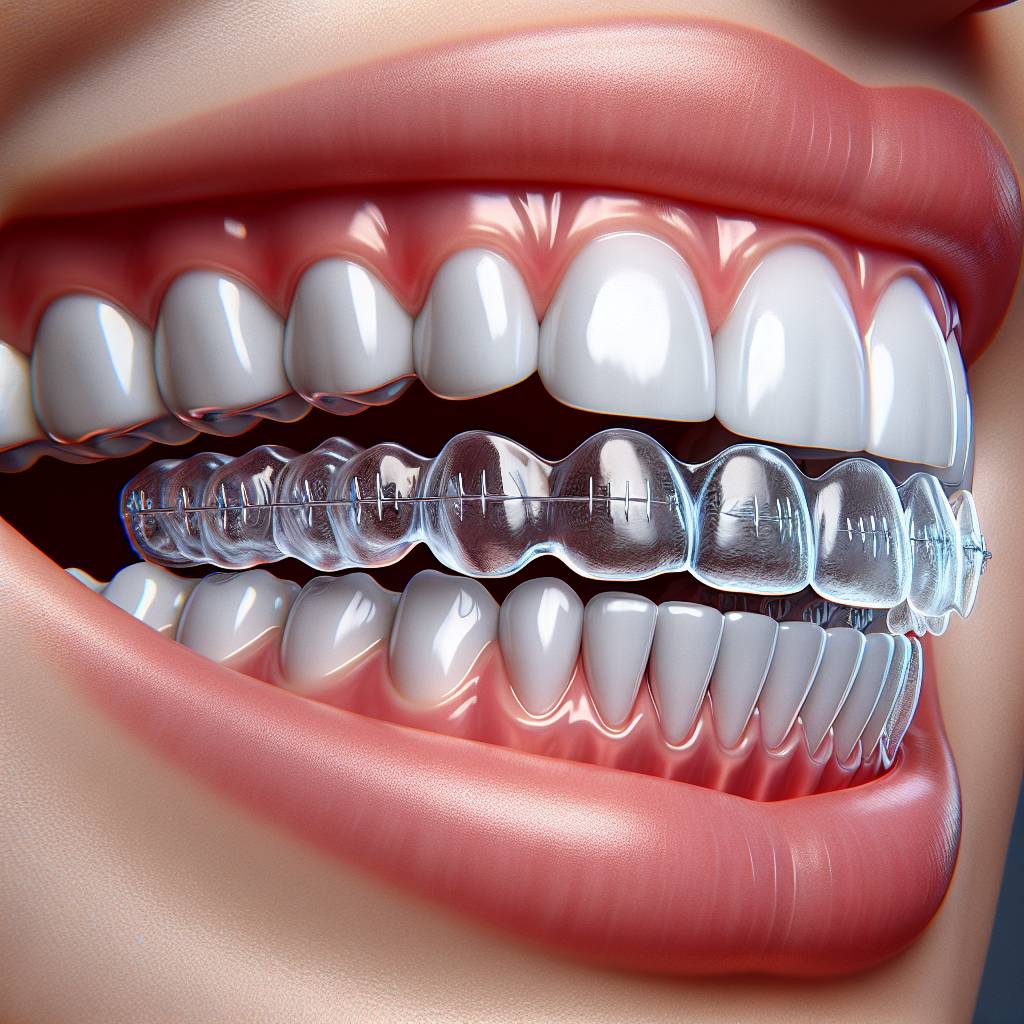Invisalign is a cutting-edge orthodontic treatment that uses a series of clear, custom-made aligners to gradually move teeth into the desired position. One of the biggest advantages of Invisalign is the speed at which it moves teeth. In this article, we will discuss how fast does Invisalign move teeth and what factors can affect the speed of treatment.Invisalign is an orthodontic treatment that uses a series of custom-made, removable aligners to gradually move teeth into the desired position. The amount of time it takes for teeth to move with Invisalign varies from person to person, but it generally takes between 9 and 15 months to complete treatment. During this time, the aligners are designed to move the teeth in small increments, usually between 0.25 and 0.33 millimeters per tray.
How Quick is the Invisalign Process?
Invisalign is a popular orthodontic treatment used to straighten teeth. It is an alternative to traditional metal braces that uses clear plastic aligners to slowly shift the teeth into their desired position. One of the main advantages of Invisalign is its quick process compared to other orthodontic treatments. On average, it takes 12 months for treatment with Invisalign, but this may vary depending on the severity of the case and how well patients comply with their treatment plan.
The time frame for treatment can vary depending on patient compliance and individual cases, but on average, patients can expect to wear aligners for one year or less. Patients may experience results sooner than expected if they follow their treatment plan properly and wear the aligners for a minimum of 20-22 hours per day as prescribed by their dentist or orthodontist.
In addition to wearing aligners as instructed, patients should also attend regular checkups with their dentist or orthodontist every 6-8 weeks during their Invisalign treatment in order to monitor progress and ensure that everything is going according to plan. This also helps to ensure that any necessary adjustments are made in a timely manner in order to maintain the integrity of the treatment plan.
Overall, while individual cases may vary, most patients can expect a quick process with Invisalign when they follow their dentist’s or orthodontist’s instructions and attend regular check-ups throughout the duration of treatment. On average, most treatments range from 12-18 months depending on the severity of the case and patient compliance.
Factors That Affect the Speed of Invisalign Movement
Invisalign is a popular orthodontic treatment that can help straighten your teeth and improve your smile. The movement of your teeth during Invisalign treatment is controlled by a variety of factors, including the amount of force used, the type of material used, and the length of time you wear the aligners. Understanding these factors can help you better understand how quickly your teeth will move during treatment, and how to get the best results from Invisalign.
The amount of force applied to your teeth is one factor that affects the speed of Invisalign movement. Generally, more force will cause your teeth to move more quickly, but it can also cause discomfort and increase the risk of gum recession or other dental damage. Your orthodontist will work with you to determine what level of force is appropriate for your specific situation.
The type of material used in your aligners can also affect the speed at which they move your teeth. Some materials are designed with a higher degree of flexibility than others, allowing them to move more quickly but also potentially causing more discomfort. Your orthodontist will be able to recommend which type of material is right for you based on your individual situation.
Finally, the amount of time you wear your aligners each day can influence how quickly they move your teeth. Generally speaking, wearing them for longer periods each day allows them to exert more pressure on your teeth and encourages faster movement than if they were worn for shorter periods. However, it’s important to follow your orthodontist’s instructions when it comes to how long you should wear them each day in order to achieve optimal results without damaging your teeth or gums.
Overall, there are several factors that affect how quickly Invisalign moves your teeth during treatment. Your orthodontist will be able to provide personalized advice about which type of material and amount of force is right for you based on your individual needs and preferences. Additionally, following their instructions for how long you should wear the aligners each day can help ensure that you get the best results in a safe and comfortable way.
What Is Invisalign?
Invisalign is a type of orthodontic treatment that uses clear, removable aligners to gradually straighten teeth. Unlike traditional braces, these aligners are made of a clear, BPA-free plastic and are virtually invisible when worn. Invisalign is an effective and discreet way to correct mild to moderate misalignment of the teeth. Depending on the severity of the case, many people can complete their treatment in 12 months or less.
What Are The Benefits Of Invisalign?
Invisalign has several benefits over traditional braces, including being more aesthetically pleasing and comfortable to wear. Invisalign aligners are removable which makes it easier to brush and floss your teeth regularly, which is important for maintaining optimal oral health. Additionally, Invisalign can be used to treat a wide range of dental issues such as crowded or gapped teeth, overbites and underbites.
What Can I Expect During Treatment?
During an Invisalign treatment plan, you will receive a series of custom-made aligners that you will wear for two weeks at a time before moving onto the next set in the series. Each set of aligners gently moves your teeth into their desired position over time. You will need to visit your dentist or orthodontist every six weeks or so for check-ups so they can monitor your progress and make any necessary adjustments along the way.
What Can I Expect After Treatment?
Once you have completed your Invisalign treatment plan as directed by your dentist or orthodontist, you can expect straighter teeth and improved oral health. It is important that you wear a retainer after treatment to ensure that your teeth remain in their new position. Depending on the severity of misalignment before treatment, this may be required for several months or even years after treatment ends.
The Benefits of Invisalign Over Other Teeth-Straightening Treatments
Invisalign is a modern teeth-straightening treatment that offers a number of benefits over traditional braces and other orthodontic treatments. With Invisalign, you can achieve the same great results as traditional braces, but with less hassle and greater convenience. Here are some of the benefits of using Invisalign over other teeth-straightening treatments:
First, Invisalign aligners are virtually invisible, making them ideal for those who want to maintain their smile without drawing attention to their orthodontic treatment. Unlike traditional braces, which are highly visible and often uncomfortable, Invisalign aligners are made from a clear plastic material that is barely noticeable when worn.
Second, Invisalign aligners are removable. This makes it much easier to brush and floss your teeth regularly while undergoing treatment. Traditional braces require special tools in order to clean around them properly, which can be inconvenient and time consuming. With Invisalign, you can remove your aligners whenever you need to clean your teeth or eat a meal.
Third, Invisalign treatment is generally quicker than traditional orthodontic treatments such as braces or retainers. The average treatment time with Invisalign is about 12 months compared to 24 months or more with traditional braces or retainers. This means you can get the beautiful smile you want in half the time with Invisalign.
Finally, Invisalign is comfortable to wear since it does not use any wires or brackets like traditional braces do. The aligners fit snugly but comfortably over your teeth without causing any discomfort or irritation as they move your teeth into place gradually over time.
In summary, there are many advantages to choosing Invisalign over other teeth-straightening treatments such as traditional braces or retainers. With its virtually invisible design, removable aligners for easy cleaning and quick treatment time, it’s no wonder why so many people choose this modern orthodontic solution for straightening their teeth.

Is Invisalign Painful?
Invisalign is a type of orthodontic treatment used to straighten crooked teeth. It uses a series of clear, removable aligners that are worn for two weeks at a time, before being replaced by the next set in the series. While Invisalign can be an effective and discreet way to straighten your teeth, there can be some discomfort associated with the treatment.
When you first start wearing a new set of aligners, you may experience some soreness and sensitivity because your teeth are shifting position. This is normal and should go away after a few days. The aligners may also cause irritation on your gums or cheeks, but this can usually be avoided by using dental wax to cover any rough edges.
It’s also important to remember that Invisalign isn’t meant to be painful – it should be comfortable enough to wear for at least 22 hours each day. If you’re experiencing pain or discomfort when wearing your aligners, it may be due to them not fitting properly. In this case, it’s best to speak with your orthodontist so they can adjust the aligners accordingly.
Overall, Invisalign should not be painful when worn correctly and adjusted as needed by your orthodontist. You may experience some mild discomfort in the beginning but this should subside after a few days as you adjust to wearing the aligners and your teeth begin moving into position.
What is Invisalign?
Invisalign is an innovative orthodontic treatment that uses a series of clear, customized aligners to straighten teeth without the use of traditional metal braces. The aligners are made from a durable, medical-grade plastic that is designed to fit snugly over the teeth. Each aligner in the series is slightly different from the previous one, gradually shifting and repositioning teeth into their desired position. The aligners are virtually invisible when worn, making them an ideal choice for adults and teens who want to improve their smiles without having to wear bulky metal braces.
How Does Invisalign Work?
The Invisalign treatment process begins with a consultation with an orthodontist or dentist. During this appointment, they will take X-rays and photographs of your teeth and use these images to create a custom treatment plan. Once the plan has been approved, you will be fitted with your first set of aligners. You will then need to wear each set for two weeks before moving onto the next set in the series. Throughout treatment, you will need to visit your orthodontist or dentist every 4-6 weeks for checkups and adjustments if needed.
How Long Does Invisalign Treatment Take?
The length of time it takes to complete Invisalign treatment depends on each individual case but typically takes between 9-18 months. During this time, you will need to wear each set of aligners for approximately two weeks before switching to the next one in the series. It is important that you wear your aligners for at least 22 hours per day in order for them to work effectively.
Are There Any Side Effects From Wearing Invisalign?
In general, there are no major side effects associated with wearing Invisalign aligners. Most people experience mild discomfort when they first start wearing their aligners but this typically subsides after a few days as they get used to wearing them. Additionally, some people may experience minor gum soreness or irritation due to the pressure of the aligner on their gums but this can be easily addressed by using dental wax or taking ibuprofen if necessary.
Are There Any Restrictions When Wearing Invisalign?
When wearing Invisalign aligners, it is important that you avoid certain foods such as popcorn kernels and hard candy as these can damage or break your aligner trays. Additionally, you should avoid smoking while wearing your trays as it can stain them permanently. Finally, you should not chew gum while wearing your trays as this can cause them to become dislodged or misaligned.
Maintaining Proper Alignment During Invisalign Treatment
Invisalign is a revolutionary treatment for straightening crooked teeth. The clear aligners shift your teeth into their desired position gradually, without the need for uncomfortable metal braces. However, it’s important to maintain proper alignment during Invisalign treatment in order to get the best results. Here are some tips to help you stay on track:
Wear Your Aligners Regularly
It’s essential to wear your aligners for 20-22 hours per day in order to ensure that your teeth move into the correct position. If you take them out too often or for too long, it may slow down the process or even cause your teeth to move back into their original position. It’s also important to remember that your aligners should be changed every two weeks or as instructed by your orthodontist.
Keep Your Aligners Clean
Your Invisalign aligners can accumulate bacteria and plaque over time, so it’s important to keep them clean. Be sure to rinse them with lukewarm water after each use and brush them gently with a soft toothbrush every day. Additionally, soak them in denture cleaner or an Invisalign cleaning solution at least once a week and store them in a case when not in use.
Visit Your Orthodontist Regularly
It’s important to visit your orthodontist regularly throughout your Invisalign treatment so they can check on your progress and make sure that everything is going according to plan. They may also need to adjust the fit of your new aligners if they are not fitting properly or have become loose due to normal wear and tear.
Avoid Hard Foods
To ensure that you maintain proper alignment during Invisalign treatment, it’s best to avoid hard foods like nuts, hard candy, ice cubes, and other crunchy items. These types of food can damage or break the aligners, which can lead to costly repairs or even set back your treatment timeline.
By following these tips, you can ensure that you maintain proper alignment during Invisalign treatment and get the best results possible. Talk with an experienced orthodontist today for more information about how they can help you achieve a straighter smile!

Conclusion
In summary, the speed of Invisalign treatment depends on a number of factors. Generally speaking, Invisalign moves teeth faster than traditional braces, with the average treatment taking around 12 months. However, it is important to note that each individual case is different and the time it takes for teeth to move will vary depending on the severity of the condition. It is best to discuss your specific case with your orthodontist in order to get a more accurate time frame for treatment.
Invisalign is an excellent alternative to traditional braces, as it offers faster and more comfortable treatment results. It is important to follow your orthodontist’s instructions and wear your aligners for at least 20 hours per day in order to achieve optimal results. With patience and dedication, you can be sure that you will have a healthy and beautiful smile in no time!

